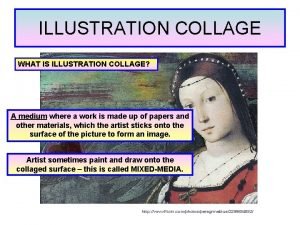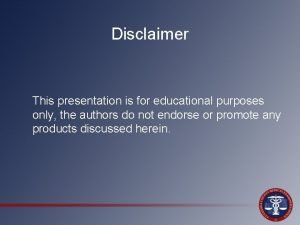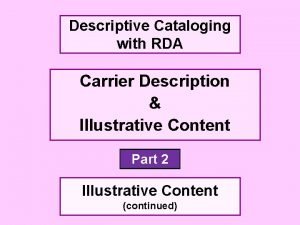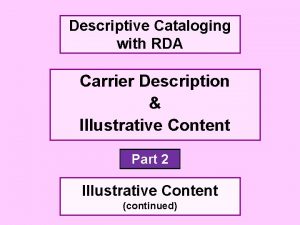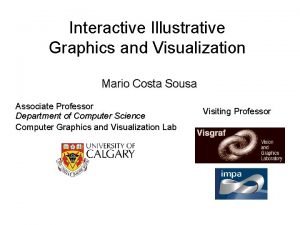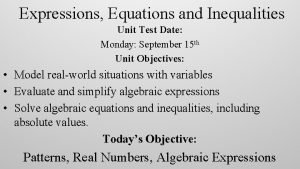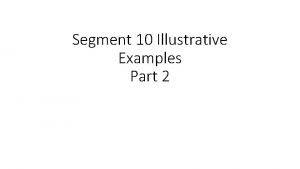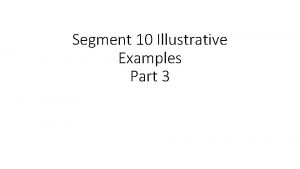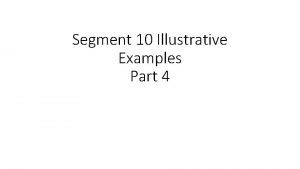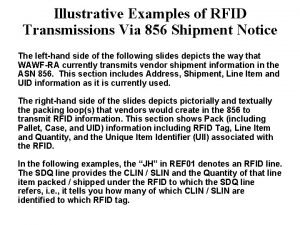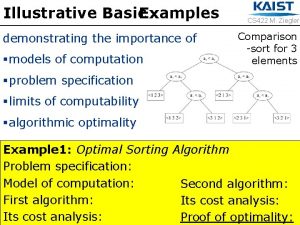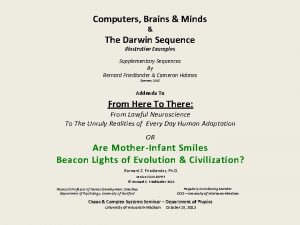Unit 7 Illustrative Examples Part 1 Illustrative Examples





















- Slides: 21

Unit 7 Illustrative Examples Part 1 Illustrative Examples

1. A. 2 Natural selection acts on phenotypic variations in populations d. Humans impact variation in other species. Illustrative example: • Artificial selection • Loss of genetic diversity within a crop species • Overuse of antibiotics (679)

Illustrative Examples: Artificial Selection: This is the type of selection in which certain traits which are more beneficial/desirable in a species are artificially selected to replicate throughout a given species. One example of this can be seen in horses, where horses that are faster or have longer heel bones are selected to breed a species of fast racehorses. Loss of genetic diversity within a crop species: Through genetic modification, humans have been able to reduce genetic diversity significantly in crops to essentially create all crops of a species the same. This however may be dangerous if a disease overcomes a species resistance and destroys an entire crop. This is the case that happened in the Irish Potato Famine Overuse of antibiotics: Antibiotics are prescribed to assist in eradicating foreign bacteria. However when heavily used, that strain of bacteria or virus may develop a resistance to that antibiotic, making the antibiotic ineffective.

1. C. 3 Populations of organisms continue to evolve b. Scientific evidence supports the idea that evolution continues to occur. Illustrative examples: • Chemical resistance (mutations for resistance to antibiotics, pesticides, herbicides or chemotherapy drugs occur in the absence of the chemical) (376 -377) • Emergent diseases • Observed directional phenotypic change in a population (Grants’ observations of Darwin’s finches in the Galapagos) • A eukaryotic example that describes evolution of a structure or process such as heart chambers, limbs, the brain and the immune system. (608 -609; 694 -696)

HEART CHAMBERS FISHES HAVE A ONE-CIRCUIT CIRCULATORY PATHWAY THROUGH THE BODY, MEANING THE HEART HAS A SINGLE ATRIUM AND A SINGLE VENTRICLE. DUE TO EVOLUTIONARY CHANGES, MANY VERTEBRATES HAVE A TWO-CIRCUIT CIRCULATORY PATHWAY.

Similar structures in different species

LIMBS THERE IS SCIENTIFIC EVIDENCE TO SUGGEST THAT HOMOLOGOUS STRUCTURES WERE FOUND IN ANCIENT ANIMAL FOSSILS. A COMBINATION OF OF FOSSILS AND GENETIC EVIDENCE SUGGEST THAT THE FINS OF DISTAL REGIONAL FISH EVOLVED INTO WRIST BONES IN MAMMALS.

BRAIN THE BRAIN UNDER WENT EVOLUTIONARY CHANGES THROUGH THE PROCESS OF NATURAL SELECTION. HUMAN ANCESTORS WERE FORCED INTO A FAST EVOLUTION AND RESEARCHERS BELIEVE THAT THE BRAIN EVOLVED INTO A LARGER, STRONGER UNIT.

Embryos of different species

Different Structures Being Similar • Vastly different species have developed similar structures and modes of development • This shows the same ancestors and thus is important to show similar structures

2. A. 3 Organisms must exchange matter with the environment to grow, reproduce and maintain organization b. Surface area-to-volume ratios affect a biological system’s ability to obtain necessary resources or eliminate waste products. Evidence of student learning: 1. As cells increase in volume, the relative surface area decreases and demand for material resources increases; more cellular structures are necessary to adequately exchange materials and energy with the environment. These limitations restrict cell size. Illustrative example: • Root hairs • Cells of the alveoli (668) • (Cells of the villi (652 -653)) • (Microvilli (652 -653))

Cells of the Alveoli= air sacs that allow for gas exchange within the lungs ● ● Thin layer that allows for gas exchange Alveolar cells= line cells ○ Simple epithelium cells ○ Alveolar macrophage cells ○ Surfactant-secreting cells Type I alveolar cells ○ Squamous Type II Alveolar cells ○ Cuboidal

Cells of the Alveoli Tiny, balloon shaped, air sac cells One cell thick Made of simple squamous tissue Lined with surfactant to maintain shape • Site of gas exchange: CO 2 enters lungs and O 2 enters blood • Simple squamous tissue allows for simple diffusion • •

2. C. 1 Organisms use feedback mechanisms to maintain their internal environments and respond to external environmental changes a. Negative feedback mechanisms maintain dynamic homeostasis for a particular condition (variable) by regulating physiological processes, returning the changing condition back to its target set point. Illustrative example: • Operons in gene regulation • (Temperature regulation in animals (600 -601)) • Plant responses to water limitations b. Positive feedback mechanisms amplify responses and processes in biological organisms. The variable initiating the response is moved farther away from the initial set-point. Amplification occurs when the stimulus is further activated which, in turn, initiates an additional response that produces system change. Illustrative example: • Lactation in mammals (757; 782 -783) • Onset of labor in childbirth (601) • Ripening of fruit c. Alteration in the mechanisms of feedback often results in deleterious consequences. Illustrative examples: • (Diabetes mellitus in response to decreased insulin (765 -767)) • Dehydration in response to decreased antidiuretic hormone (ADH) (688; 757) • (Grave’s disease (hyperthyroidism) (761)) • (Blood clotting (620 -621))

Lactation in Mammals - - During lactation, the hypothalamus signals the anterior pituitary to secrete prolactin. This stimulates the glands to produce milk in response to suckling from a newborn. In addition to the secretion of prolactin is the secretion of oxytocin, which causes the release of milk as a response to suckling. Another positive feedback loop is the oxytocin pathway. Mammary glands will secrete milk in response to the circulation oxytocin. The response will cause more suckling and more stimulation. This pathway will continue to be activated until the baby stops suckling.

• Positive feedback mechanisms amplify responses and processes in biological organisms. The variable initiating the response is moved farther away from the initial set-point. Amplification occurs when the stimulus is further activated which, in turn, initiates an additional response that produces system change.

• Alteration in the mechanisms of feedback often results in deleterious consequences.

2. C. 2 Organisms respond to changes in their external environments a. Organisms respond to changes in their environment through behavioral and physiological mechanisms Illustrative example: • Photoperiodism and phototropism in plants • Hybridization and migration in animals • Taxis and kinesis in animals • Chemotaxis in bacteria, sexual reproduction in fungi • (Nocturnal and diurnal activity: circadian rhythms (768)) • Shivering and sweating in humans (600 -601)

2. C. 2 Shivering and Sweating in Humans ● ● Negative feedback loop- brings body temperature back to set point Shivering- occurs when the body temperature is below normal ➔ control center enables blood vessels constrict which conserves heat ➔ nerve impulses are sent from the control center to the skeletal muscles to begin shivering ➔ heat is generated to gradually rise body temperature

2. C. 2 Shivering and Sweating in Humans ● ● Negative feedback loop- brings body temperature back to set point Sweating- occurs when the body temperature is above normal ➔ control center signals the blood vessels on the skin to dilate this allows heat to be lost into the environment sweat glands are activated by the nervous system the evaporated sweat lowers body temperature ➔ ➔

• Negative feedback mechanisms maintain dynamic homeostasis for a particular condition (variable) by regulating physiological processes, returning the changing condition back to its target set point.
 Illustrative case study example
Illustrative case study example Illustrative essay example
Illustrative essay example What is illustrative collage
What is illustrative collage Video disclaimer for educational purposes only
Video disclaimer for educational purposes only Pwc ifrs 17
Pwc ifrs 17 Illustrative content
Illustrative content Illustrative case study
Illustrative case study Illustrative descriptive material
Illustrative descriptive material Mario costa sousa
Mario costa sousa Unit 10, unit 10 review tests, unit 10 general test
Unit 10, unit 10 review tests, unit 10 general test Part part whole addition
Part part whole addition Part to part ratio definition
Part to part ratio definition Part part whole
Part part whole What is a technical description?
What is a technical description? Under bar parts
Under bar parts The part of a shadow surrounding the darkest part
The part of a shadow surrounding the darkest part 미니탭 gage r&r 해석
미니탭 gage r&r 해석 Ap psychology unit 7 memory
Ap psychology unit 7 memory Ap physics unit 7 mcq part a
Ap physics unit 7 mcq part a Kite definition geometry
Kite definition geometry System of equations and inequalities unit test
System of equations and inequalities unit test Expressions, equations, and inequalities unit test part 2
Expressions, equations, and inequalities unit test part 2


